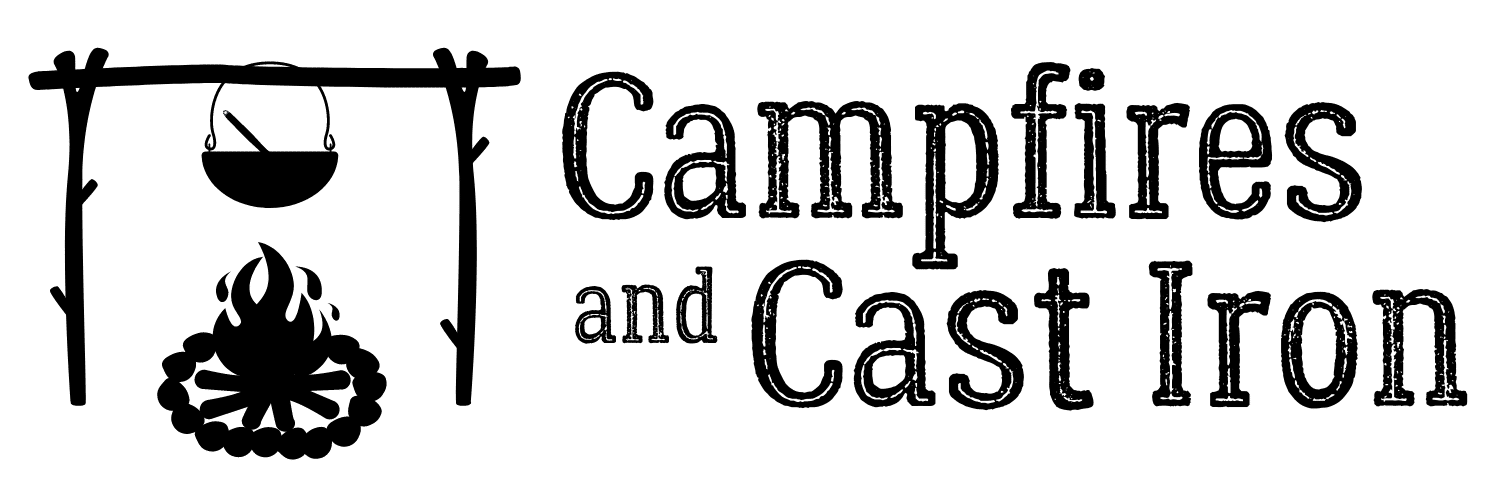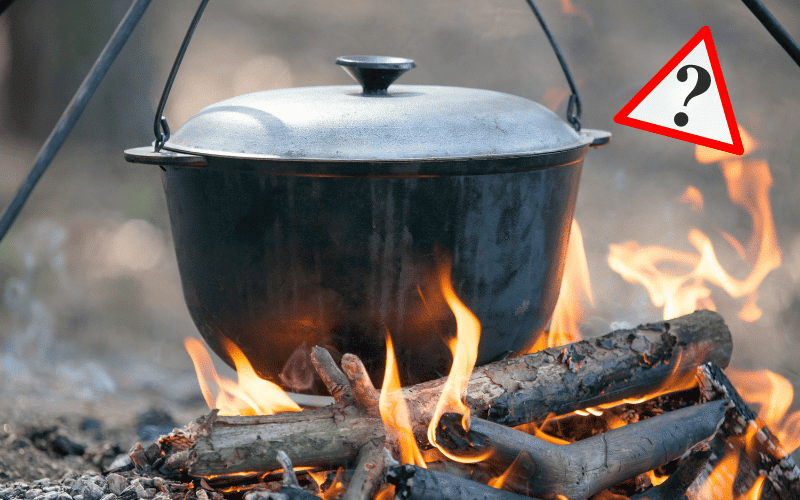Last updated on July 21st, 2021
You’re ready to go camping and you want to cook some tasty meals over the campfire, but the only cast iron pot you have is an enameled dutch oven. Is it safe to use it over an open fire or on hot charcoal? Let’s take a look at why this may or may not be a good option.
Can you use an enameled dutch oven over a campfire? Using an enamel-coated dutch oven is not recommended over an open fire or directly on hot charcoal. Enameled cookware may not withstand these high temperatures, which can cause the enamel coating to crack, chip, and flake off. An open fire can also permanently burn or stain the enamel coating.
If enameled dutch ovens are not meant for outdoor cooking, how should they be used? What should you do if you already used your enamel-coated dutch oven over a campfire and now it’s cracked? Which type of dutch oven is the best choice for use over a campfire or on the grill? Keep reading as we explore these answers below.
What Is An Enameled Dutch Oven?
An enameled, or enamel-coated dutch oven is simply a cast iron dutch oven that is coated in a porcelain enamel glaze. The glaze is made of finely-powdered glass that is melted and fused to the porous surface of the cast iron in a high-heat furnace. Once coated with enamel, the surface of the dutch oven does not require seasoning like regular cast iron. The coating allows for easier cleaning and prevents rusting. These types of dutch ovens have temperature limitations and are meant for indoor cooking on the stovetop or in the oven.
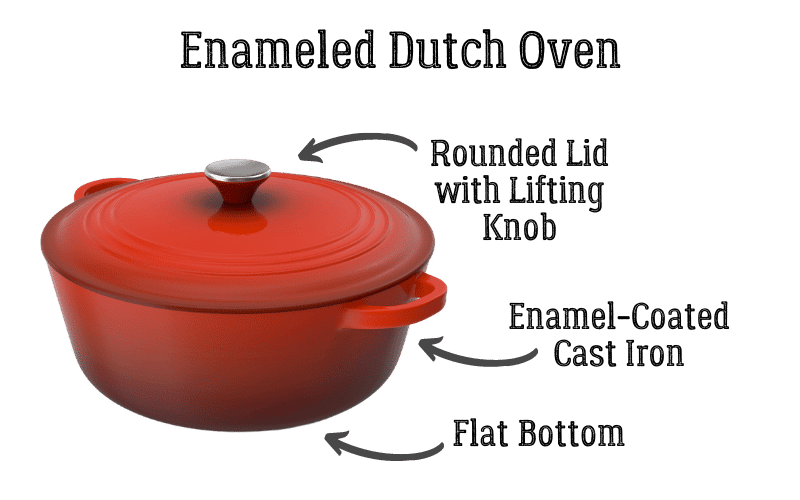
Why Enameled Cast Iron Shouldn’t Be Used Outdoors
Enameled dutch ovens can be used on electric, gas, ceramic, glass, and induction stovetops, and in the oven. One particular high-end brand claims their enameled cast iron products can be used on barbecue grills. However, most manufacturers advise against this. The unpredictable heat and flame height of many outdoor grills can exceed the safe temperature limit, crack the enamel, and render the pot useless.
The same is true for use over an open fire, even if the pot is elevated on a cooking grate. Because the temperature and flame height of the fire cannot be controlled, the potential rapid heating and cooling of the enamel-coated cast iron can cause too much expansion and contraction of the metal, leading to cracks in the porcelain enamel coating. In addition, the soot and residue from the fire could permanently stain the enamel. In short, it’s best to protect your beautiful, shiny enameled dutch oven by only using it indoors.
I Used My Enameled Dutch Oven Over A Campfire And It Chipped. Can I Still Use It?
Let’s say you’ve already tried cooking over a campfire or on the grill with your enamel-coated dutch oven and it chipped or cracked. Oops. That’s not good. But can you still use it?
In this case, it depends on where the chip or crack is located. If the chip or crack is superficial, only involves the enamel, and isn’t on the cooking surface, it will likely still be safe to use for future indoor cooking.
If the chip involves the cooking surface, such as on the inside bottom or sidewalls that would come in contact with food, most cookware companies advise you to stop using the damaged pot. This is because the enamel could continue to chip off while cooking and end up in food.
Additionally, if the iron underneath the enamel coating is cracked, the pot should be discarded for safety reasons. A crack in the iron could cause the pot to fracture or shatter when subjected to high temperatures or significant temperature changes, such as when putting a cold pot on a hot stove or pouring cold water into a hot pan.
Enamel-coated dutch ovens aren’t intended for use in the great outdoors, but there are other types of dutch ovens that are made specifically for outdoor cooking. They are safe to use directly over a fire and can withstand the high, unpredictable heat without chipping or cracking. These models are discussed in more detail below.
Cast Iron Dutch Ovens For Outdoor Cooking
If you’re planning to cook outdoors over a campfire, on charcoal, or on a grill, your best bet is to invest in a non-coated, plain cast iron dutch oven. When it comes to cast iron dutch ovens, there are two basic designs: an indoor, or regular version and an outdoor, or camping version. Let’s take a closer look at these types:
Indoor or Regular Dutch Oven
The indoor or regular dutch oven is made of plain, non-coated cast iron. It will need to be seasoned regularly, just like a cast iron skillet. It has a flat bottom and a rounded lid. Most also have handles on the sides and top of the pot.
Although the name suggests this model can only be used indoors, this type of dutch oven actually has many outdoor uses. While the flat bottom allows for use on stovetops and the rounded lid isn’t designed for holding coals like its camping counterpart, the indoor dutch oven can still safely be used on a gas or charcoal grill, over an open campfire, or nestled in hot coals. It can also be elevated on bricks or rocks to allow room for hot coals underneath without making contact with the bottom of the pot and scorching food. I use and recommend this brand.
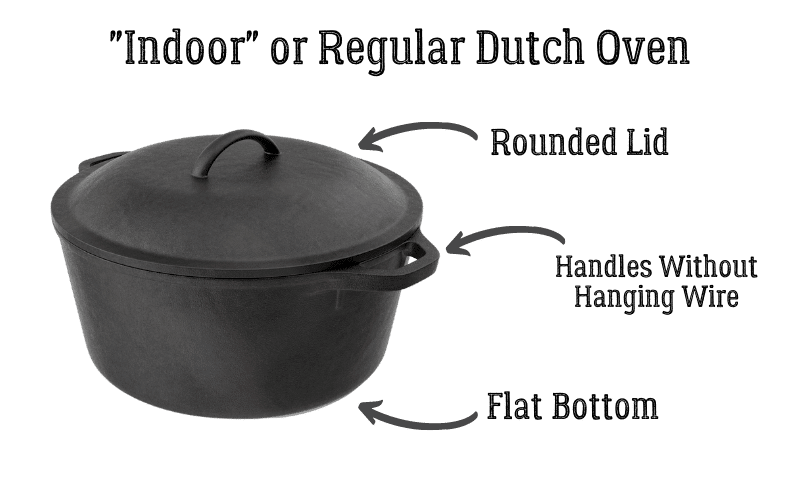
Outdoor or Camp Dutch Oven
The outdoor, or camp dutch oven, is also made of plain, non-coated cast iron and will require regular seasoning. The main differences in this type of dutch oven are that it has three sturdy legs to raise the pot above hot coals, the lid is flatter and has a flanged edge for holding coals, and it usually has a wire handle for hanging over a fire and transporting the pot.
The camp dutch oven is arguably the best and most versatile dutch oven for outdoor cooking. It can withstand the high heat of being placed directly in or over the campfire, in hot coals, on the grill, or on a propane camp stove. The flanged lid allows for placement of charcoal on top of the pot to heat the contents from both the top and bottom, much like an indoor oven. The combination of the iron legs that elevate the pot slightly above the charcoal and the lid that holds hot coals allows users to, with some practice, bake breads, cobblers, and many other recipes outdoors without burning the bottom of the food.
An additional benefit of the camp dutch oven is that on most models, the lid can be turned upside down and used as a griddle. Who doesn’t love multi-functional cookware? This two-in-one lid-griddle can be used directly over hot coals or on a special stand over the fire to cook bacon, scramble eggs, make pancakes, and much more! Being able to sear, fry, slow-cook, simmer, bake, and griddle with one piece of cooking equipment saves space in your camp kitchen and opens up a world of delicious outdoor meal possibilities. One of my favorite camp dutch ovens can be purchased on Amazon.
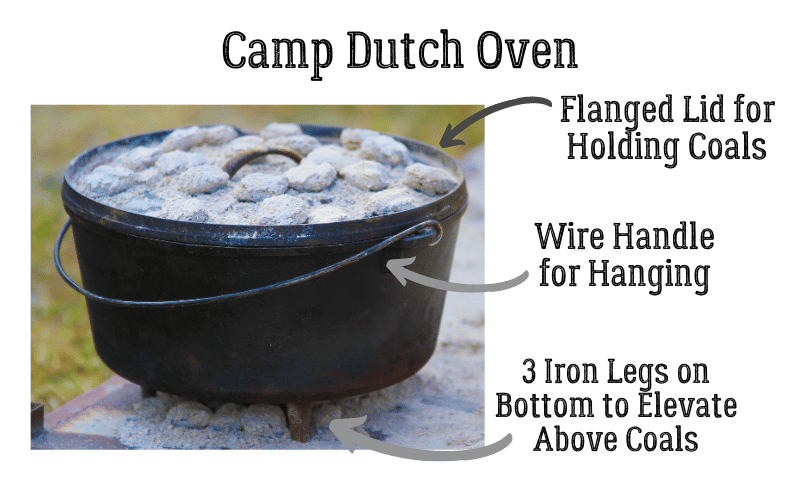
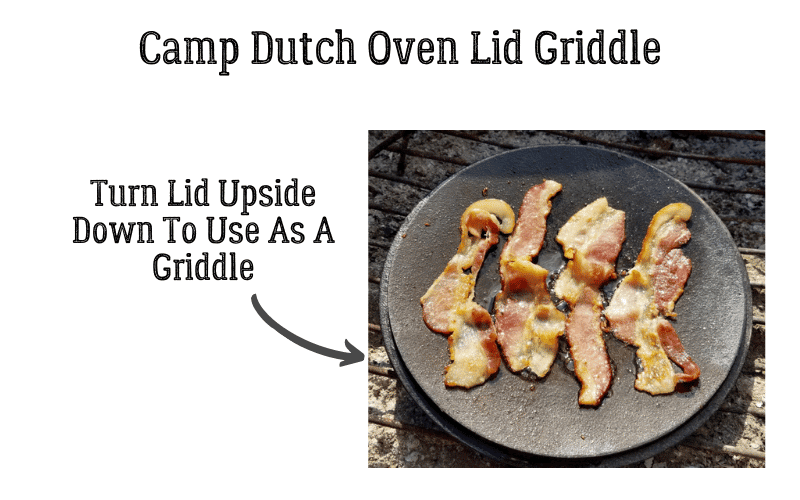
Dutch Oven Types And Where To Use Them: A Summary Table
In summary, the enameled dutch oven should only be used to cook indoors to preserve the safety and integrity of the pot. While the indoor and camp dutch ovens have their differences, both are good options for use while camping or cooking outdoors. The table below offers a quick comparison of all three dutch oven models:
| Enameled Dutch Oven | Indoor Dutch Oven | Camp Dutch Oven | |
| Indoor Stovetop | Yes | Yes | No – Iron legs on bottom will prevent proper contact with stovetop |
| In An Oven | Yes | Yes | Yes |
| Propane Camp Stove | Yes – Similar to using a gas burner on an indoor stove | Yes | Yes |
| On A Grill | Not Recommended | Yes | Yes |
| In A Campfire | No | Yes | Yes |
| Hanging Over A Fire | No | Yes – If the pot has a wire handle for hanging | Yes |
| On Hot Charcoal | No | Yes | Yes |
Now that you know which types of cast iron dutch ovens are suitable for outdoor cooking, it’s time to make some delicious campfire meals!
This post may contain affiliate links. This means if you click on a link and make a purchase, I will receive a small commission, at no cost to you, that makes it possible for me to keep the Campfires and Cast Iron site up and running. Please see our disclosure policy for details.
